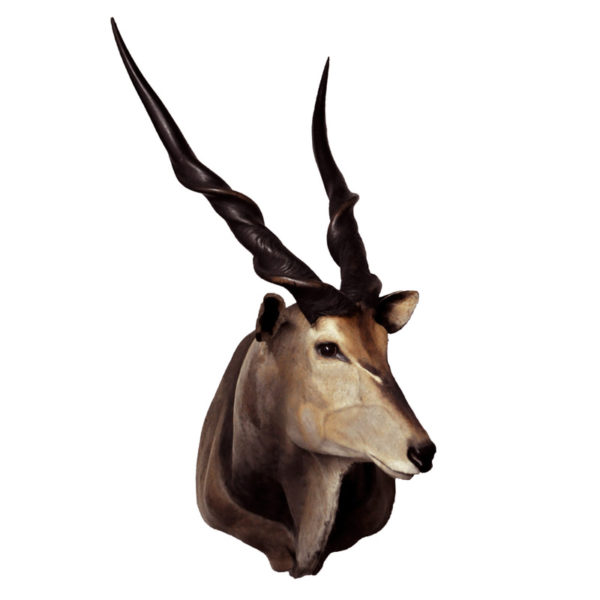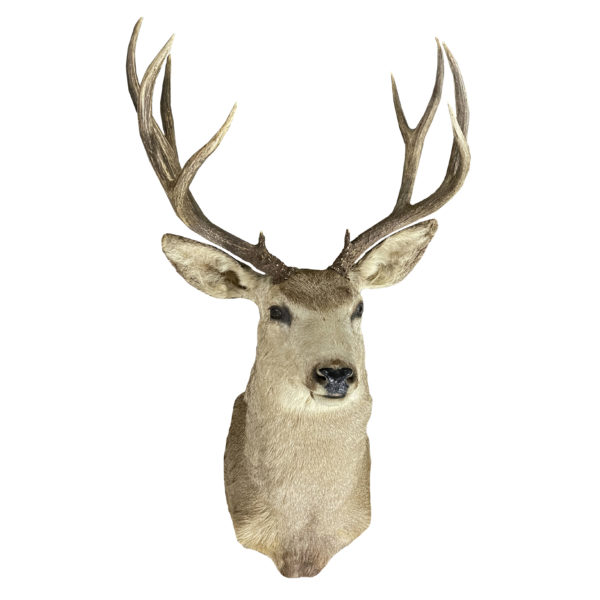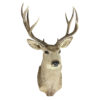35
$18,336
Find high quality Anteater taxidermy pieces at Taxidermy Trophies for Sale. We have the perfect lifelike anteater mounts to accent your home, office or cabin. These long snouted insect eating animals are easily recognizable around the world. Aardvarks, The tamandua, and Giant Ant Eaters are all represented in high quality full bodied specimens. Taxidermy trophies for sale is proud to offer these rare, high quality pieces. Perfect for a collector or for a unique decorative piece. They are available for sale and ready to ship!
 Antelopes
AntelopesShop our selection of African Sculptures & Statues from the world’s premier auctions and galleries. Taxidermy Trophies for Sale carries a wide selection of African-themed carvings, sculptures and statues. These works of African art are an elegant addition to your home or office. We have Zaire bronze sculptures, Congo wood carvings and Zimbabwe carvings, Cameroon Masks for sale and ready to ship.
Taxidermy Trophies for Sale has a unique selection of genuine African throwing spears for sale and ready to ship. Spears are an ideal decorator accent item for African-themed home decor, not to mention great conversation pieces! Spears can be placed decoratively in a large vase or easily mounted to your wall.
African Themed Furniture
Find framed Butterfly display professionally preserved in museum shadowbox at taxidermy trophies for sale. From Giant Morpho Butterfly Displays to Flying Butterfly Collections, you’ll find a wide array of exotic Butterfly taxidermy or Entomology mounts for sale in a variety of styles. Perfect for any butterfly-themed home decor or nature home decor. These butterfly mounts are preserved to last years hanging in your collection or as an individual collectible. These real, preserved butterfly displays in frame are for sale, in stock, and ready to ship! All frames are Double Glass, unless marked otherwise. Please contact us with any questions about our mounted butterfly decor items.
TTFS carries an assortment of unique Entomology gifts and items, including Butterfly Bookmarks, Soaked Scientific Insect Specimens, Bugs in Acrylic Paperweights and more! For more info on any item or to place an order, please contact us!
Find framed insect display professionally preserved in museum shadowbox at taxidermy trophies for sale. From Tarantula Insect Displays to Flying Beetle Collections, you’ll find a wide array of exotic and real Insect specimen mounted taxidermy or Entomology mounts for sale in a variety of styles. Perfect for any exotic or science-themed home decor or nature home decor. These insect and bug mounts are preserved to last years hanging in your collection or as an individual collectible. These insect display frames are for sale, and ready to ship! Please contact us with any questions about our mounted insect decor items.
Deer antler Chandelier, Horn Lamp, Wildlife Chandelier, Rustic chandelier, Cowboy Chandelier and Western lighting, at Taxidermy Trophies for sale, we have you all covered. The wide selection features a variety of deer antler Chandelier, metal Chandelier, cowboy Chandelier with high quality at low prices.
Deer antler Lamp, Horn Lamp, Wildlife lamps, Rustic lamps and decorative lighting, at Taxidermy Trophies for sale, we have you all covered. The wide selection features a variety of deer antler lamp, metal lamp, animal sculpture lamp with high quality at low prices.
Deer antler Candle Holder, Wildlife Candle Holder, Rustic Candle Holder, Metal Candle Holder, Cowboy Candle Holder, at Taxidermy Trophies for sale, we have you all covered. The wide selection features a variety of deer antler Candle Holder, metal Candle Holder with high quality at low prices.
Find beautiful sea themed art pieces and ocean-themed decoration items at Taxidermy Trophies for Sale. We have a collection of fish sculptures, sea life sculptures, fish paintings. Discover the unique piece you like at taxidermy trophies for sale today and liven up your home or cabin with these decoration items. Act quickly as these gorgeous items are one of a kind and will not remain in stock for long.
Exotic African Animal Skins, Hides, Rugs and Throws for sale at Taxidermy Trophies for sale. We have a large selection of African Animal Skins, Hides and rugs including Greater Kudu skin, Zebra Skin, Springbok Skin, Bushbuck hide, Blackbuck skin rug, Gemsbok hide, Hartebeest Skin, Wildebeest hide, Nyala skin and more…
Real Australian Alpaca Rug and Kangaroo Rug for sale at taxidermy trophies for sale. We have a large selection of Australian Alpaca Rug, Kangaroo hide Rug all ready to ship around! We offer high quality Australian Alpaca Rug and Kangaroo hide Rug at low prices. Discover unique piece you like and liven up your home or cabin.
Premium Cowhide Rugs for sale at affordable prices. We have Tricolor Cowhide, Brown & White Cowhide, Black & White Cowhide and Brindle Cowhide. Each of our Cowhide Rugs is one of a kind, featuring unique variations in coloring and cut. Use one to add instant character to bedrooms and living rooms, it is the best choice for our high quality and low prices.
Real Deerskin rug for sale at taxidermy trophies for sale. We have a large selection of Deer hide rug including Axis Deer rug, Whitetail Deer Skin, Elk Deer Skin, Mule Deer Rug, all ready to ship around! We offer high quality Deerskin and Deer Hide rug at low prices. Discover unique piece you like and liven up your home or cabin.
Fox and Coyote Fur for sale at taxidermy trophies for sale. We have a large selection of Fur and Pelts including Arctic Fox Fur, Coyote Pelt, Red Fox Fur, Silver Fox pelt, all ready to ship around! We offer high quality Fox and Coyote Fur at low prices. Discover unique piece you like and liven up your home or cabin.
Real Rabbit Skin for sale at taxidermy trophies for sale. We have a large selection of Rabbit Skin, all ready to ship around! We offer high quality Rabbit Skin at low prices. Excellent choices for designers and DIY lovers and we offer Wholesale Prices for everyone!
Real animal skin rug with taxidermy head for sale at taxidermy trophies for sale. We have Bobcat Hide with Head, Grey Fox hide with Head and Rocky Mountain Goat with Head, all ready to ship around! We offer high quality animal skin rug with taxidermy head at low prices. Discover unique piece you like and liven up your home or cabin.
Real Sheepskin and genuine Goatskin rug for sale at taxidermy trophies for sale. We have a large selection of Icelandic Sheepskin, Mongolian Sheepskin and Goatskin with various color and pattern, all ready to ship around! We offer high quality Sheepskin and Goatskin rug at low prices. Discover unique piece you like and liven up your home or cabin.
Genuine Zebra Skin Rugs for sale at TTFS. We sell top quality real Zebra skins rugs, all ready to ship! Find unique natural patterns of different pieces, We also carry zebra skin pillows, please go to our Pillows . Discover unique piece you like and liven up your home or cabin.
Bring focus to your home with these stunning, antler racks and euro mounts for sale. Shop our selection of antlers from Whitetail deer, Elk to Moose and Stags. From elegantly simple antlers to gorgeously complex nests of interlocking antlers, we have the perfect Antler rack or Euro mount for your wildlife-themed home, restaurant or log cabin.

Find high quality Anteater taxidermy pieces at Taxidermy Trophies for Sale. We have the perfect lifelike anteater mounts to accent your home, office or cabin. These long snouted insect eating animals are easily recognizable around the world. Aardvarks, The tamandua, and Giant Ant Eaters are all represented in high quality full bodied specimens. Taxidermy trophies for sale is proud to offer these rare, high quality pieces. Perfect for a collector or for a unique decorative piece. They are available for sale and ready to ship!
 Antelopes
AntelopesShop our selection of African Sculptures & Statues from the world’s premier auctions and galleries. Taxidermy Trophies for Sale carries a wide selection of African-themed carvings, sculptures and statues. These works of African art are an elegant addition to your home or office. We have Zaire bronze sculptures, Congo wood carvings and Zimbabwe carvings, Cameroon Masks for sale and ready to ship.
Taxidermy Trophies for Sale has a unique selection of genuine African throwing spears for sale and ready to ship. Spears are an ideal decorator accent item for African-themed home decor, not to mention great conversation pieces! Spears can be placed decoratively in a large vase or easily mounted to your wall.
African Themed Furniture
Find framed Butterfly display professionally preserved in museum shadowbox at taxidermy trophies for sale. From Giant Morpho Butterfly Displays to Flying Butterfly Collections, you’ll find a wide array of exotic Butterfly taxidermy or Entomology mounts for sale in a variety of styles. Perfect for any butterfly-themed home decor or nature home decor. These butterfly mounts are preserved to last years hanging in your collection or as an individual collectible. These real, preserved butterfly displays in frame are for sale, in stock, and ready to ship! All frames are Double Glass, unless marked otherwise. Please contact us with any questions about our mounted butterfly decor items.
TTFS carries an assortment of unique Entomology gifts and items, including Butterfly Bookmarks, Soaked Scientific Insect Specimens, Bugs in Acrylic Paperweights and more! For more info on any item or to place an order, please contact us!
Find framed insect display professionally preserved in museum shadowbox at taxidermy trophies for sale. From Tarantula Insect Displays to Flying Beetle Collections, you’ll find a wide array of exotic and real Insect specimen mounted taxidermy or Entomology mounts for sale in a variety of styles. Perfect for any exotic or science-themed home decor or nature home decor. These insect and bug mounts are preserved to last years hanging in your collection or as an individual collectible. These insect display frames are for sale, and ready to ship! Please contact us with any questions about our mounted insect decor items.
Deer antler Chandelier, Horn Lamp, Wildlife Chandelier, Rustic chandelier, Cowboy Chandelier and Western lighting, at Taxidermy Trophies for sale, we have you all covered. The wide selection features a variety of deer antler Chandelier, metal Chandelier, cowboy Chandelier with high quality at low prices.
Deer antler Lamp, Horn Lamp, Wildlife lamps, Rustic lamps and decorative lighting, at Taxidermy Trophies for sale, we have you all covered. The wide selection features a variety of deer antler lamp, metal lamp, animal sculpture lamp with high quality at low prices.
Deer antler Candle Holder, Wildlife Candle Holder, Rustic Candle Holder, Metal Candle Holder, Cowboy Candle Holder, at Taxidermy Trophies for sale, we have you all covered. The wide selection features a variety of deer antler Candle Holder, metal Candle Holder with high quality at low prices.
Find beautiful sea themed art pieces and ocean-themed decoration items at Taxidermy Trophies for Sale. We have a collection of fish sculptures, sea life sculptures, fish paintings. Discover the unique piece you like at taxidermy trophies for sale today and liven up your home or cabin with these decoration items. Act quickly as these gorgeous items are one of a kind and will not remain in stock for long.
Exotic African Animal Skins, Hides, Rugs and Throws for sale at Taxidermy Trophies for sale. We have a large selection of African Animal Skins, Hides and rugs including Greater Kudu skin, Zebra Skin, Springbok Skin, Bushbuck hide, Blackbuck skin rug, Gemsbok hide, Hartebeest Skin, Wildebeest hide, Nyala skin and more…
Real Australian Alpaca Rug and Kangaroo Rug for sale at taxidermy trophies for sale. We have a large selection of Australian Alpaca Rug, Kangaroo hide Rug all ready to ship around! We offer high quality Australian Alpaca Rug and Kangaroo hide Rug at low prices. Discover unique piece you like and liven up your home or cabin.
Premium Cowhide Rugs for sale at affordable prices. We have Tricolor Cowhide, Brown & White Cowhide, Black & White Cowhide and Brindle Cowhide. Each of our Cowhide Rugs is one of a kind, featuring unique variations in coloring and cut. Use one to add instant character to bedrooms and living rooms, it is the best choice for our high quality and low prices.
Real Deerskin rug for sale at taxidermy trophies for sale. We have a large selection of Deer hide rug including Axis Deer rug, Whitetail Deer Skin, Elk Deer Skin, Mule Deer Rug, all ready to ship around! We offer high quality Deerskin and Deer Hide rug at low prices. Discover unique piece you like and liven up your home or cabin.
Fox and Coyote Fur for sale at taxidermy trophies for sale. We have a large selection of Fur and Pelts including Arctic Fox Fur, Coyote Pelt, Red Fox Fur, Silver Fox pelt, all ready to ship around! We offer high quality Fox and Coyote Fur at low prices. Discover unique piece you like and liven up your home or cabin.
Real Rabbit Skin for sale at taxidermy trophies for sale. We have a large selection of Rabbit Skin, all ready to ship around! We offer high quality Rabbit Skin at low prices. Excellent choices for designers and DIY lovers and we offer Wholesale Prices for everyone!
Real animal skin rug with taxidermy head for sale at taxidermy trophies for sale. We have Bobcat Hide with Head, Grey Fox hide with Head and Rocky Mountain Goat with Head, all ready to ship around! We offer high quality animal skin rug with taxidermy head at low prices. Discover unique piece you like and liven up your home or cabin.
Real Sheepskin and genuine Goatskin rug for sale at taxidermy trophies for sale. We have a large selection of Icelandic Sheepskin, Mongolian Sheepskin and Goatskin with various color and pattern, all ready to ship around! We offer high quality Sheepskin and Goatskin rug at low prices. Discover unique piece you like and liven up your home or cabin.
Genuine Zebra Skin Rugs for sale at TTFS. We sell top quality real Zebra skins rugs, all ready to ship! Find unique natural patterns of different pieces, We also carry zebra skin pillows, please go to our Pillows . Discover unique piece you like and liven up your home or cabin.
Bring focus to your home with these stunning, antler racks and euro mounts for sale. Shop our selection of antlers from Whitetail deer, Elk to Moose and Stags. From elegantly simple antlers to gorgeously complex nests of interlocking antlers, we have the perfect Antler rack or Euro mount for your wildlife-themed home, restaurant or log cabin.
$1,045
1 in stock
The Mule Deer (Odocoileus hemionus) is an iconic species of western North America, easily identified by its forked antlers, large ears, and powerful stature. Unlike whitetail deer, mule deer antlers bifurcate—splitting into two main branches and then dividing again—creating a distinctive and symmetrical look that collectors value.
This species thrives in deserts, foothills, and mountainous terrain across the western United States, southwestern Canada, and northern Mexico. Known for their unique “stotting” gait, where all four hooves hit the ground simultaneously, mule deer are highly adapted to rugged landscapes.
Scientific Name: Odocoileus hemionus
Range: Western U.S., Alberta, British Columbia, northern Mexico
Size: Males can weigh up to 300 lbs
Antlers: Shed and regrown annually; highly valued in hunting and wildlife displays
Behavior: Solitary or in small groups, with bucks often seen alone outside the rut
Ecological Role: A key herbivore and prey species in North American ecosystems
This large shoulder mount captures the commanding presence of a mature mule deer, making it ideal for rustic interiors, lodges, or wildlife educational displays.
| Dimensions | 44 × 25 × 24 in |
|---|


